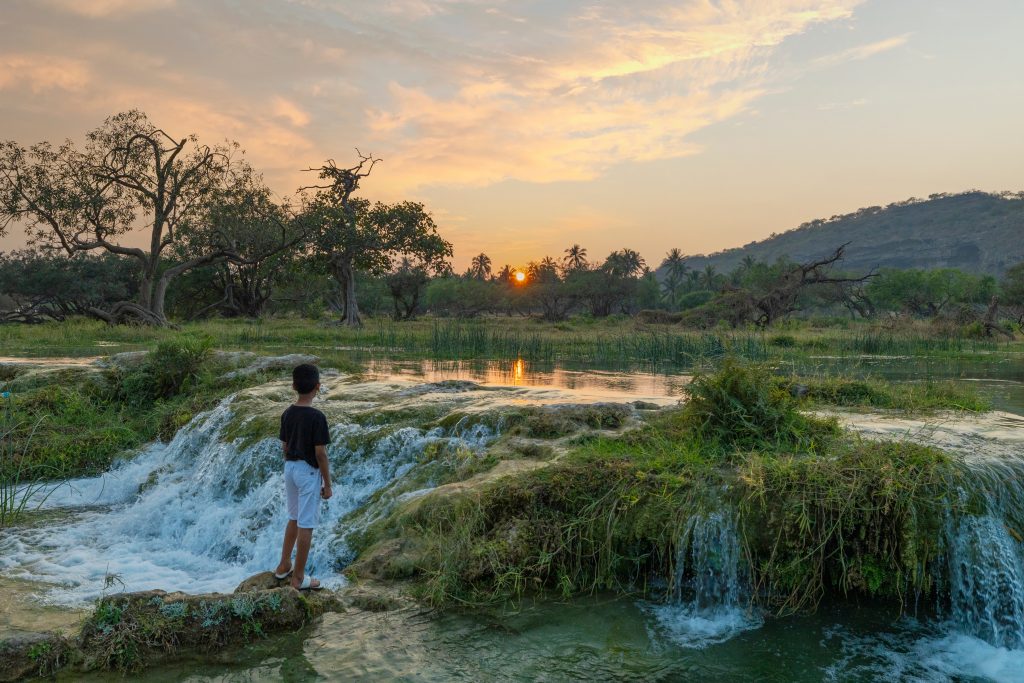Discovering Mehri: A Unique South Arabian Language
By Sahara Al-Madi
Uncover the enchanting world of Mehri, one of the last surviving South Arabian languages, spoken in the misty mountains of Oman and Yemen.

In the lush, mountainous region of Dhofar, Oman, the poetic language of Mehri thrives among its speakers. As one of the last surviving South Arabian languages, Mehri carries a rich cultural heritage, with stories passed down through generations. However, this unique language faces the threat of extinction, as there is currently no established writing system. According to Ethnologue, Mehri is classified as endangered. In this article, we’ll delve into Mehri’s history, its linguistic structure, and ongoing efforts to preserve this precious language.
Why Mehri and South Arabian Languages Matter: Cultural and Historical Significance
Mehri is one of six languages in the Modern South Arabian (MSA*) family, which includes Ḥarsusi, Baṭḥari, Soqoṭri, Hobyot, and Jibbali. Despite being located in an Arabic-speaking region, MSA languages are not derived from Arabic and are not mutually intelligible with it. Studying Mehri and its MSA counterparts offers valuable insights into the diverse history and cultural perspectives of the people in this region.
Aaron Rubin, a distinguished Malvin and Lea Bank Professor at Penn State University, specializes in Classics, Ancient Mediterranean Studies, Jewish Studies, and Linguistics. His research on the Mehri language reveals that approximately 130,000 speakers inhabit the easternmost governorate of Al-Mahra, Yemen, as well as the neighboring Dhofar governorate in Oman. This valuable insight highlights the significance of Mehri in understanding the region’s linguistic diversity and cultural heritage.
In addition to Mehri, Rubin’s work encompasses other Modern South Arabian (MSA) languages, including Ḥarsusi, Baṭḥari, Soqoṭri, Hobyot, and Jibbali (also known as Shaḥri, Śḥeri, or Śḥerɛ̄t). Each of these languages adds to the rich tapestry of linguistic variety in the region, with Mahri, Jibbali, and Soqoṭri featuring multiple dialects that reflect the unique cultural identities of their speakers. By studying these languages, Rubin not only contributes to academic knowledge but also helps preserve the vibrant traditions and histories embedded in them. This research is crucial for fostering appreciation of the region’s cultural diversity and ensuring that these languages continue to be spoken and celebrated.
Below is a diagram of the Proto-Semitic language family provided by Hassan Obeid Alfadly et al.

Mehri in Popular Culture
Discover Four Popular Mehri Songs Showcasing Traditional Instruments and Poetic Heritage of the Region:
In Dhofar, Oman, and Al-Mahra, Yemen, a vibrant cultural tradition brings communities together to celebrate in nature through collective drumming.
Experience this unique custom by watching a video that captures locals gathering in the mountains to play their drums and share in the joy of music below.
Linguistic Analysis
Linguists analyze lexical cognates, which are words that share a common origin, by examining patterns of sound correspondences across different languages. This analysis reveals significant evidence of language evolution and the relationships between languages. By understanding these connections, linguists can trace the historical interactions among languages and their speakers. This research not only enhances our knowledge of the languages themselves but also provides valuable insights into the cultures and histories of the communities that speak them (Hoijer, 1956; Bergsland and Vogt, 1962).
Cognate Words in Mehri and Hadhrami Arabic
Key Initiatives to Preserve and Revitalize the Mehri Language
I first encountered Mehri through another language named Shahri, or Jibbali. Unfortunately, there is very limited documentation on Shahri, which is reported to have around 50,000 speakers. Despite its challenges, the survival of such languages highlights the profound connection people have to their cultural identities.
To help save Mehri, a dedicated group of scholars is leading several important initiatives. Professors Thomas Muir Johnstone and Aaron Rubin are focused on documenting the language and creating dictionaries to make it more accessible for study. Meanwhile, Professor Miranda Morris emphasizes the cultural significance of Mehri by showcasing its traditional stories, poetry, and music. Professors Hassan Obeid Alfadly and Khaled Awadh Bin Mukhashin are actively engaging local communities, encouraging younger generations to learn and use Mehri. Additionally, there are plans to establish educational programs in schools to teach the language, fostering pride in its rich heritage and ensuring its survival for the future. Together, these efforts are vital for revitalizing Mehri and celebrating its unique cultural legacy.
Each language carries a unique story, fostering authentic connections among speakers that transcend borders and generations. Embracing and preserving these languages is essential for maintaining the rich tapestry of human expression and recounting the history of the land. I hope that the topics we explored today have inspired you to learn more about Mehri and other Modern South Arabian languages.
Sources
Alfadly, Hassan Obeid, and Khaled Awadh Bin Mukhashin. “Cognate Words in Mehri and Hadhrami Arabic.” Hadhramout University Journal of Humanities, vol. 16, no. 2, 2019, hu.edu.ye, https://hu.edu.ye/hu-publications/journals/index.php/hujh/article/view/208.
Beeston, A. F. L. “T. M. Johnstone: Mehri Lexicon and English–Mehri Word-List, with Index of the English Definitions in the Jibbāli Lexicon, Compiled by G. Rex Smith.” Bulletin of the School of Oriental and African Studies, vol. 52, no. 2, 1989, pp. 353–354.
Morris, Miranda. “The Mehri Language of Oman.” The Journal of the American Oriental Society, vol. 132, no. 3, July 2012, pp. 482–87. go.gale.com, https://go.gale.com/ps/i.do?p=AONE&sw=w&issn=00030279&v=2.1&it=r&id=GALE%7CA314256026&sid=googleScholar&linkaccess=abs.
Rubin, Aaron D. “Preface.” Omani Mehri. Brill, 2018, https://brill.com/view/book/9789004362475/front-8.xml. Accessed 26 Oct. 2024.

